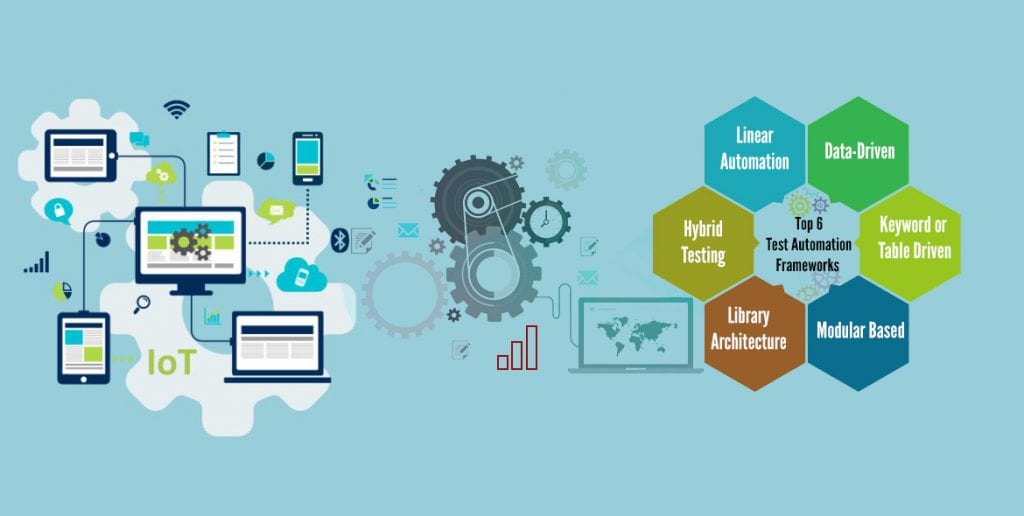Automation testing cannot succeed without an effective test automation framework. Changes in user behavior have brought changes in automation test trends. Machine learning and artificial intelligence have been incorporated into test automation to enable testers to achieve the maximum benefit of functional testing. There are several test automation frameworks for web and mobile application testing and each of them have different combinations of features. The crucial factor that determines the success of any automated testing effort is choosing the right test automation framework.
What is a Test Automation Framework?
A test automation framework is an environment that facilitates the execution of automation test scripts. Through the framework, the user can develop, execute and report the results of automation test scripts effectively.
A test automation framework is a system specifically created to automate testing. The framework follows coding standards, guidelines, practices, and processes that are necessary for automation testing. By following the guidelines, the user can take advantage of the framework features and view productive results.
A test automation framework offers ease in scripting, modularity, scalability, reusability, reduced cost and maintenance. Developers can either use a single test automation framework or multiple frameworks while working on different application modules.
Benefits of using a Test Automation Framework
Here are the main benefits of using test automation frameworks:
Minimum Human Intervention
Automation testing tools take care of repetitive tasks to free up the team’s time for other complex tasks. The automation framework takes care of most of the quality assurance operations without needing human intervention.
Early detection of bugs
A test automation framework provides detailed documentation of software defects that help the teams to identify defects easily and resolve it with minimum cost and effort. Early bug detection ensures correct functionality and speeds up development.
Reduced time-to-market
An effective test automation framework allows constant execution of test cases without any obstacles. Automated test library executes quicker, runs longer, thereby reducing the time-to-market of the application.
Better Testing Efficiency
Since testing forms a major part of the application development lifecycle, even a minor improvement in efficiency can impact the overall project timeframe. Automated tests take lesser time to run, do not need supervision and the results can be monitored at the end of the process.
Improved ROI
Since automated tests take up lesser time and resources, the quality of work improves and there are lesser errors and glitches. This in turn reduces the need for fixing bugs that incur high costs giving a boost to the organization’s ROI.
Greater Test Coverage
In an automated testing framework, a greater number of tests can be run for a single application. This improves the test coverage, enables testing of more features and enhances the application quality which would consume a massive amount of time and manpower in manual testing.
Reusability Feature
The repetition of test cases in an automated testing framework helps developers analyze program results easily. Moreover, the reusable automated test cases can be used for various test scenarios due to their easy configuration and reusability feature.
Types of Test Automation frameworks
The common types of test automation frameworks used for automation testing are:
⮚ Data-driven Testing Framework
⮚ Hybrid Testing Framework
⮚ Library Architecture Testing Framework
⮚ Module Based Testing Framework
⮚ Behavior Driven Development Framework
Top Test Automation Frameworks for 2021
Test automation trends have evolved over the years based on user behavior, emergence of artificial intelligence and machine learning. Consequently, test automation tools have upgraded over the years with newer features and offerings. You must select your tool based on the current requirement, project budget, and the ability of the testing team to adapt to any tool. Given below are the top test automation frameworks for 2021:
Functionize is an intelligent test automation platform built to test modern applications. Unlike other cloud-based testing solutions, Functionize’s technology is deeply rooted in big data and data science. It collects millions of data points from your application when the test is created and again every time tests are run. This means that machine learning builds a complex model of your application in the cloud. So, when your UI changes, your tests autonomously heal. Functionize is well suited for teams of all skill sets, as it’s a low-code platform. Yet, it’s powerful for engineers who wish to extend tests with code
Selenium
Selenium is the best automation tool for web application automation testing. This commonly used testing framework is an open-source tool compatible with major browsers, programming languages including Java, Python, C#, Groovy and most operating systems. Selenium has advanced, detailed automation scripts, supports parallel execution of test cases, and supports integration of other software testing tools. The main advantage of the Selenium framework is that it supports code maintenance.
Users can run Selenium automated test scenarios on LambdaTest, a secure, reliable, and scalable cloud-based Selenium grid. They can perform real-time cross-browser immersive testing of their websites on the cloud and public or local web apps.
LambdaTest reporting solutions integrated with Selenium offer detailed test logs that help in quick debugging of test scripts. The tool also offers video recordings of the entire script execution along with screenshots of each step.
Selenium supports browser-based automation testing, regression testing, bug reproduction scripts, and centralized management of multiple environments.
Robot
Robot automation testing framework is the best choice for Python-based testing efforts. Mainly Python-based, the Robot framework can be used with Java and .NET as well. The keyword-driven approach of the Robot framework helps users to create and run tests easily. The Robot framework has several libraries and API’s to improve its extensibility.
Users can run Python-based test automation scripts effectively on LambdaTest Selenium cloud platform. You can run your test cases on scalable Selenium infrastructure that supports real operating systems and browsers.
WebDriverIO
The WebDriverIO automation testing framework is based on Node.js. Its integrated test runner enables testers to run automation tests for web apps as well as native mobile apps. The test framework can run on both Chrome Devtools and WebDriver protocol making it effective for Selenium web driver based cross-browser testing and Chromium based automation.
You can configure and run your JavaScript automation test scripts on LambdaTest Selenium Cloud platform through Selenium WebDriver IO.
Citrus
Citrus is an open-source automation testing framework where the user can integrate tests based on different data format or messaging protocol such as HTTP, REST, SOAP or JMS. Citrus can be integrated with Selenium to leverage the user interface and verify the back end process. Citrus can receive email or message communication triggered by the UI, verify the back-end results all together in a single test.
Cypress
Cypress is a developer oriented test automation framework to drive test-driven development. Cypress design principle involves packaging and bundling all features to make the entire testing experience simple and pleasant. Unlike Selenium, Cypress’ architecture runs inside of the browser to ensure accurate and consistent results. Cypress allows users to get synchronous notifications for every event inside the browser and native access to every element.
Gauge
Gauge is an open-source test automation framework that works on Linux, Mac OS and Windows. Gauge focuses on creating executable documentation. The test scripts can be written using languages such as Java, C#, or Ruby within existing IDE like Eclipse or Visual Studio. The Gauge tool’s functionality can be extended with plugin support and the UI/API tests can be driven by Selenium or any other testing tool.
Serenity
Serenity is a Java-based testing framework that integrates with BDD (Behavior-driven development) tools such as Cucumber. Serenity makes writing automated regression and acceptance tests easier. The test scenarios are maintained at a high level while implementation details are retained at a lower level. Serenity also provides a lot of built-in functionality such as WebDriver management, parallel testing, screenshot generation, and so on without writing a single line of code.
Cucumber
Cucumber, an open-source platform is based on Behavior Driven Development (BDD). Cucumber is designed only for web access with focus on high levels of user satisfaction. The main features of Cucumber are code compatibility with other frameworks, support for Gherkin code and other languages such as Java, Ruby, and Groovy.
Specification and testing documentation are available in a single document that is updated regularly. Business stakeholders who have less knowledge of testing can easily read the code and test reports that are in simple English. Cucumber test code can be used together with other frameworks like Watir, Selenium and so on.
You can configure and run your JavaScript based automation test scripts on LambdaTest Selenium cloud platform using Cucumber js framework.
Carina
Carina is another popular open-source automation testing framework that is independent of any technology stack. The user can test native/web/hybrid mobile applications, databases, and REST services through this tool. Carina testing framework supports databases such as SQL Server, MYSQL, Oracle, and many more. It supports all popular browsers, mobile devices and its automation test code can be reused between iOS or Android. Carina test framework works across platforms and tests can be efficiently run on both Windows OS and Unix.
EarlGray
EarlGray from Google has a built-in synchronization feature that makes the test scripts wait for UI events to complete before it attempts to interact with the app’s UI. This kind of implementation makes the test scripts systematic and concise. All the steps will show the path of the test script and the way UI is going to synchronize with it. All UI elements of the EarlGray framework impact only the visual elements, offering a quick and robust approach to the entire testing process.
Conclusion
The above list of test automation frameworks represents the commonly used automation tools with AI/ML capability that can effectively address organizational challenges. The choice of test automation framework must be based on the current organizational needs and future potential enhancements. An effective test automation framework is one that supports data generation, basic optimization, smart, scalable solutions, and analytics.







